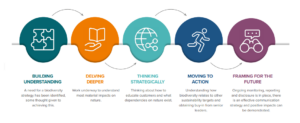A pathway to a nature positive fashion industry


Nature is our life support system – human societies and economic activities rely on it. However, biodiversity, the living component of nature, is declining at an unprecedented rate due to human activity. One million out of an estimated eight million species of plants and animals are threatened with extinction.
But there are opportunities to reverse this: the landmark signing of the Global Biodiversity Framework by governments at the Convention on Biological Diversity (COP15) in 2022 could help end what UN Secretary-General António Guterres has called a “senseless, suicidal war against nature.”
What is clear is that success will depend on our ability to reshape industries, including fashion, to become nature positive.
Climate change and nature loss are two sides of the same coin. Yet, while many in the fashion industry have taken important initial steps to address the climate crisis, action on biodiversity loss has lagged behind. Often, this is not because of a lack of awareness, but a lack of understanding; about the problems and the solutions..
“Reaching net-zero is not possible without nature. And nature is fast declining. The fashion industry is uniquely dependent on natural ecosystems for its materials and operations. Understanding the industry’s environmental impacts and enabling businesses to take actionable and measurable strategies on nature are critical first steps to system change” – Eva von Alvensleben, Executive Director & Secretary General of The Fashion Pact
Nature loss is a complex challenge that can only be solved through systems change, but for many brands and retailers, understanding their place in that change presents an overwhelming barrier. Some become trapped in analysis paralysis, others attempt to resolve the challenge across so many fronts they fail to have a significant impact on any – leading to a risk genuine efforts become dismissed as greenwashing, and customers, colleagues, peers and policymakers become increasingly frustrated or disengaged.
Fashion is highly dependent on biodiversity and nature from the supply of nature-dependent commodities like cotton, animal hides, and new or innovative materials like, mycelium leather, hemp and bamboo, to clean water and healthy soils. Over the coming decade, we will see environmental changes redefine competitive advantages for all businesses, investors and countries. Access to water, energy, soil and food will completely reshape these advantages, and changing trends in consumer behaviour and preferences, will mean businesses must consider both the impacts of these patterns on demand and how their actions can influence a more circular economic model that promotes demand for nature-positive products in the future. To ensure longevity and resilience, businesses need to reset their thinking around value creation and their business models.
In response to these challenges, the Fashion Pact and Conservation International, with funding from the Global Environment Facility, partnered with Cambridge Institute for Sustainable Leadership (CISL) to develop a Biodiversity Roadmap for fashion, textiles and apparel. It sets out many of the questions they will face, as well as the tools to help them answer them as part of the two-year project Transforming the Fashion Sector with Nature.
Progress towards a nature-positive fashion industry, begins for any organization with an understanding of where they are today.
To do that it is helpful to consider:
- The awareness and knowledge of biodiversity, and its connections with climate change and social wellbeing
- The understanding of the tools and frameworks that exist or are under development
- The status of biodiversity strategy development, including clarity of objectives and the types of nature projects the business is engaged in
- The extent to which nature is culturally embedded across the business, including leadership buy-in and support, and internal interest and commitment
- The awareness of evolving regulations and policies (eg EU Nature Restoration Law, the Corporate Sustainability Reporting Directive
Only once an organization is clear about where it stands today, can it identify the next steps that will deliver the most impact. The Roadmap plots five key steps for businesses on a nature-positive journey, from building internal understanding within to monitoring, reporting and communicating impact. At each stage it signposts tools and resources developed through our Transforming the Fashion Sector with Nature project, which can help them.

“In the midst of an ecological crisis, it is more vital than ever for companies to shift to regenerative business models which value, protect and restore nature. It’s time for the fashion, textile and apparel industry to play its part in building a nature-positive economy, and the CEOs and companies who move without delay will reap the benefits – and so will their investors,” – Paul Polman, business leader, co-chair and co-founder of The Fashion Pact.
Creating a nature-positive fashion industry will take ongoing effort. A business’ impact on the natural world will change over time, as will nature’s response to those impacts. Leading businesses will continue to respond to these changes, continuing to review and improve their strategies.
This roadmap must be viewed in the wider context of evolving targets, changing regulation, and the ability of businesses to lead internal strategic change – through transformative leadership, empowered workforces and a culture that supports innovation and ideas.